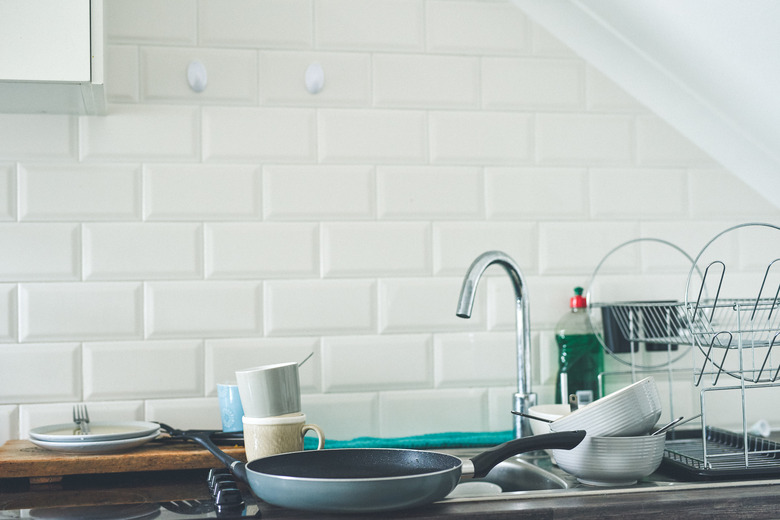How To Remove Flatware Marks From Dishes
From brand-new dish sets to family heirloom dishes used only on special occasions, flatware marks can make those well-cared-for dishes look less than their best. These gray lines won't come off with a regular washing but can be removed with a mild abrasive.
Faux Scratches on Dinner Plates
Faux Scratches on Dinner Plates
Those grayish marks that look like scratches on dinner plates aren't scratches at all; they're marks from kitchen cutlery. Virtually any metal object can leave gray marks on light-colored dishes, especially stoneware, porcelain and specialty glass dishes such as Corelle plates. These blemishes are thin layers of metal left behind when a metal utensil scrapes across the dish surface. Unlike actual scratches, these marks are usually not permanent and can be scrubbed away.
If you prefer dinnerware that doesn't show silverware marks, some forms of glazed ceramic dishes are less likely to develop these metallic markings. Look for ceramics with a thick, clear layer of glaze or protective sealant. Darker colors of dinnerware are also less likely to show flatware marks; even if these marks develop, they'll be less obvious than on a typical white or light-colored dinner plate.
As far as flatware is concerned, there's no metal flatware that won't mark dishes. Any metal is capable of leaving its mark on a typical dinner plate. Non-metal flatware, however, won't leave such marks.
Removing Flatware Marks
Removing Flatware Marks
A gentle, mildly abrasive household cleanser removes gray flatware marks from virtually any type of kitchenware. Look for a powdered cleanser such as Bon Ami that has a label stating no harsh chemicals are in the product. Wet the dish surface, then sprinkle on enough cleanser to cover the gray markings. Scrub the dish with a nylon scrub pad; some metal scouring pads may leave more marks on the dish. Rinse the dish off; if gray marks remain, scrub again with more cleanser.
Some dinnerware companies such as Pfaltzgraff also sell their own brand of mild cleaning products that are specifically designed to remove metal markings from dishes and even mugs. This type of cleanser can be used on any brand of kitchenware.
Other Options for Mark Removal
Other Options for Mark Removal
If you don't have a gentle cleanser handy, a paste made from baking soda and water also removes gray flatware marks. Mix just enough water into the baking soda to make a fairly wet paste, then dip a damp dishcloth into the paste. Rub the paste over the affected dish surfaces. Rinse the paste away afterward. In some cases, baking soda may not completely remove the marks.
A melamine foam "magic" eraser also removes some flatware marks on dishes, although it may not be as effective as a cleanser. Wet the foam, then rub it over the gray lines on the dish. Wash the dish with regular dish soap and water afterward.
Preventing Flatware Marks
Preventing Flatware Marks
Although you may not be able to prevent all flatware marks, assuming you stick with using your usual flatware and dishes, you can prevent some marks that happen when handwashing dishes. Wash flatware and metal kitchen utensils such as spatulas separately from the dishes and mugs that show flatware marks.
These can still be washed in the same dishwater, just at a separate time. For instance, wash all the metal items first, then glassware, then heavy dishes, followed by pots, pans and bakeware. Choose whichever order works best for you, saving the greasiest items for last.
